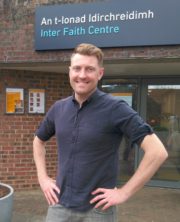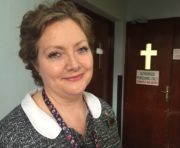In the second episode of Ministry of Hope, Mater hospital chaplain, Margaret Sleator, supports Sahin Yasar, a 15-year-old boy, and his family, who are desperately waiting for a heart transplant. Prison chaplain, Catherine Black, spends Christmas with the inmates of Shelton Abbey Open Prison. And at Dublin City University, Philip McKinley finally manages to lure the mainstream Irish students into the Interfaith chaplaincy with an offer of free pancakes for Shrove Tuesday.
Sahin Yasar’s mother, Tina, is an Irish Catholic; his father, Apo, is a Turkish Muslim. Both have seen their faith severely tested over the last 3 months, as their teenage son waits for the call to say that a suitable heart donor has been found. ‘You pray the phone rings… He is literally cracking up,’ says Tina. ‘There is nothing else I can do. What I’m doing isn’t good enough.’ Lay chaplain, Margaret Sleator, who serves patients of all faiths, can see that the Yasar family ‘…feel time is running out for them. My prayer would be that something will happen very soon for him, but the reality is that there are more people waiting as well.’
For Wexford native, Margaret, it can be hard to offer emotional support to patients and their loved ones facing difficult situations where she knows the outcomes are not always good. ‘It affects me a great deal. It is not supposed to, but I certainly would have my moments where I go to the bathroom and the mascara is half way down the face.’ That mascara, though, remains one of Margaret’s trade marks, along with her bold choices of lipstick, as she tries to encourage other people’s brave faces with her own.
In Shelton Abbey Open Prison, in Arklow, chaplain Catherine Black celebrates Christmas with the inmates. ‘It’s kind of mixed emotions… It’s bitter sweet here,’ she says, ‘because some of them have great expectations to get out and be with their families, but inevitably, some of them won’t be out for Christmas.’ One of the prisoners, Martin, says, ‘That’s the chance you get in an open prison like Shelton… I think I have abided by the rules, so I hope to get a couple of days out at Christmas. (But) it can be as hard to come back… ’cause you’re leaving your loved ones behind.’
Catherine also has to deal with the prisoners who have to spend Christmas in jail. ‘In the next couple of days,’ says Catherine, ‘when lads are getting the decision whether they are getting out or not, we will try and listen to that disappointment or frustration and help them have the tools to cope with that. And it’s not always easy.’
For Philip McKinley, there are challenges to being a religious chaplain in a secular university like Dublin City University. Recently, the function of university chaplains has come under increased scrutiny. ‘Ireland is at a particular phase of decline in religious practice, and therefore it is inevitable that there are questions asked about university chaplaincy and its role,’ says Philip. He doesn’t duck any of the hard questions. In fact, he asks them himself: ‘Are we adding value? Is it a role that should continue? What is it that chaplaincy adds to the university? And if chaplaincy wasn’t there, what would that look like…?’
While the DCU Interfaith Centre is very popular with students from overseas and from minority groups, it takes the enticement of free pancakes to bring the more mainstream Irish students finally flocking into the centre on Shrove Tuesday. 1st year student, Mark Caffrey, who is a committed Catholic and a regular at the Interfaith Centre, sees no harm in that. ‘Free food will attract anyone to anything. This is one of those good things that will draw people in who might not normally go… There are definitely folks who would not like to see any visible presence from the Church. For a number of different reasons, I think that would be a tragedy.’









